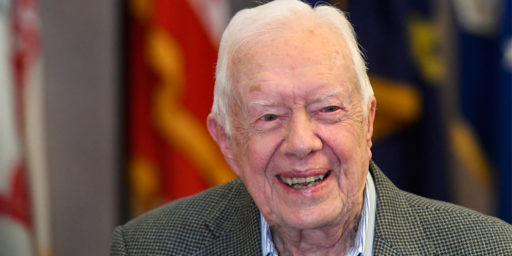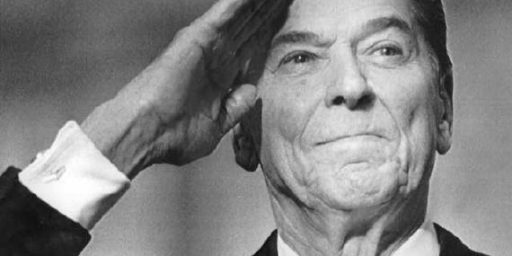Bush Behind Even Though Ahead?
Polls Put Bush on the Edge (Ron Brownstein, LAT)
While most of America is watching the spread in the polls between President Bush and Sen. John F. Kerry, key strategists in both parties have their eyes on a different set of numbers: Bush’s share of the vote and his job approval in the final surveys before election day.
Analysts watch the incumbent’s numbers in the polls so closely because most voters who stay undecided until the very end of a presidential campaign traditionally break for the challenger. As a result, challengers often run ahead of their final poll results, while incumbents rarely exceed their last poll numbers. “We know from the history of presidential elections that when a president is polling below 50% going into the election, he usually loses,” said Alan I. Abramowitz, an Emory University political scientist. “That is true of incumbent office holders in general. The incumbent usually ends up getting the percentage that he is getting in the final polls — that’s it.”
By that standard, the race today is teetering right on the knife’s edge, though perhaps tilting slightly toward Bush after he regained the lead in five separate national polls released over the weekend. More importantly, for the first time since the debates, Bush in three of the latest surveys cracked the 50% level in support — the best news GOP strategists have seen in weeks.
Surveys released Saturday by Newsweek and ABC/Washington Post put Bush’s support at 50% among likely voters. On Sunday, Bush reached 52% among likely voters in a CNN/USA Today/Gallup Poll, opening an 8-percentage-point advantage over Kerry. But a survey released over the weekend by Time placed Bush at 48% — as did the Newsweek result among registered voters. And the daily tracking poll by independent pollster John Zogby on Sunday put Bush at 46% with likely voters. Among registered voters, Bush got 49% in the new Gallup Poll.
Hmm. Let’s see. We have a whole series of polls showing Bush with a lead with two weeks to go. And yet the focus is on the fact that he’s only slightly above a meaningless 50% threshhold? Because undecided voters typically rally for the challenger? Riiight.
History isn’t always predictive, but races involving White House incumbents have produced a clear pattern over the last 50 years. Since Gallup began systematic polling in 1952, eight incumbents have sought reelection. Bill Clinton in 1996, Jimmy Carter in 1980, Gerald Ford in 1976, Lyndon B. Johnson in 1964 and Dwight D. Eisenhower in 1956 all attracted a smaller share of the vote on election day than they did in the final Gallup survey. Richard M. Nixon in 1972 and Ronald Reagan in 1984 finished almost exactly at their final polling numbers. George H.W. Bush in 1992 ran seven-tenths of a percentage point ahead of his final poll number, the biggest increase for any incumbent since 1952. The one exception to this pattern was in 1948, when Gallup polled less often, and the final survey, begun in mid-October, missed Harry S. Truman’s late surge; Truman exceeded his final poll number by a full 5 percentage points.
Conversely, challengers — like Reagan in 1980, Carter in 1976, Barry Goldwater in 1964 and Adlai Stevenson in 1956 — have frequently polled higher on election day than in the final survey.
So, our data consists of eight cases, one of which was before television began to dominate political campaigns and only one of which takes place during the modern era of 24/7 news coverage? Of the eight, three are exceptions to the rule being asserted. And all based on a single poll, Gallup? And, oddly, Gallup is the poll with Bush well over 50%?
It’s also worth noting that four of the eight races in the sample involved substantial third party candidates, whose numbers are often quite volatile: conservative Democrat George Wallace in 1972, liberal Republican John Anderson in 1980, the highly popular Ross Perot in 1992, and a dimished Perot in 1996. Nader will apparently be a virtual non-factor in the national vote, given that he hovers in 1% range.
There are all sorts of reasons for Bush supporters to be worried in what continues to be a close race. This seems to be among the sillier, however.






The numbers look fine for Bush except that polling is looking rather bad in Ohio. I wish those numbers would return to safer levels.
I think Bush has a great deal to worry about in thesse latest numbers. Just calling Browenstein’s analysis “silly” really doesn’t do it justice.
I hope Mellman &co don’t take your blase attitude into the final days, that would be a huge mistake with RCP leaning PA and OH for Kerry and FLA no better than leaning W.
First of all, Ron has tended to be somewhat (for an LA Times columnist) positive on Bush’s reelect chances. And while probably a liberal (if for no other reason than those wimpy eyeglasses he sports), he is one of the definite thought leaders as pundits go, tending to come up with new rationales rather than going with the conventional wisdom.
Secondly, I don’t see how it’s damning that “only one” election with an incumbent was in the modern era of news coverage. What is the logical connection we are supposed to be drawing here because it sure isn’t obvious.
Next, I don’t see the 50% approval threshold as meaningless at all. The very point of the whole article (one by the way that has been championed by John Zogby for months now) is that approval numbers are far more reliable than polling numbers. I don’t quite get the “riight” conclusion on that – seems like your flat out opinion.
Today’s Zogby numbers have the race at a tie – so maybe Browenstein is onto something here.
I am 1000% for Bush but very worried. What all these polls show is there are still 6 or 7 percent undecideds. If they break 60% to 70% for Kerry like they did for Gore in 2000, then we are in trouble. I am very concerned that both Rasmussen and Zogby show a dead heat.
Noel, dead on. Rasmussen tends to goose up W and today is worrysome. On the other hand, the shift is within the margin of error, so the math would seem to say a tie is going to crop up now and then even if due to random effects.
Being dismissive without analysis can be disasterous and lead to unwarrented expectations.
Bush lead Gore by 3-points in 2000 (LV polls). Gore won by 1 point (reality). The independents went 40/Gore 60/Bush as Gore was a VP and fell under a weak-form of the incumbant rule.
Obviously something was wrong with the polls. I think the popluation identification is bad. With Gallup being the worst as theirs is just insanly GOP friendly.
LV polls are biased from their over-sampling Republican-identified and under-sampling Democrat-identified. Historically “Republican identified” have never broken 35% of the voting populace, and those are in LOW turnout races as Republican turnout is very consistent, whereas Democratic turnout isn’t. Yet these polls are running up to 39% Republican.
Does this not a cause for concern? Or are these dubious leads grist for more meaningless bravado?
The polls may be accurate to the population with a MoE. But the wrong population is being surveyed.
Then we have the undecided question. Reagan has the historically highest undecided break. 20%. Undecideds are at least 4% of the population right now. And Bush’s average poll (on the Republican-favoring RealClearPolitics) has Bush with an under 3% spread and 48.7% poll.
That’s not good. That, plus the LV problem is putting Bush behind Kerry. Then dump in a larger than 2000 Democrat turnout and the youngsters voting to avoid the real specter of a draft. And the on-going Republican voter scandles and charges of Jim Crow… A lot of older (Eisenhower) Republicans are crossing for Kerry.
Right now, I’ve read that upto 20% of Kerry’s support is Republican. Whereas Bush is only pulling 11% of his from the Democrats.
Anyway, this’ll be an interesting election vis the various theories of voter participation and sampling bias. I’m getting a gut feeling that Bush is going to get a really nasty surprise. I know too many moderate Republicans that have switched sides and very few Democrats.
Even in mutlti-generational Republican families, such as my own, where we literally have NO democrats and nephews & neices that serve as Congressional aides, Bush has less than 50% support.
I’ll be honest. I’ll be surprised if he wins.
None of these polls are based on turnout OVER 50%.
Those of you who are math wizards……how does this change things?
With Kerry As our New President, I will rest better at night! Our Forefathers warned of the dangers of our involvement with the middle east!
Bush is playing with Fire! We are not safe under his greed, ignorance and coruptions.